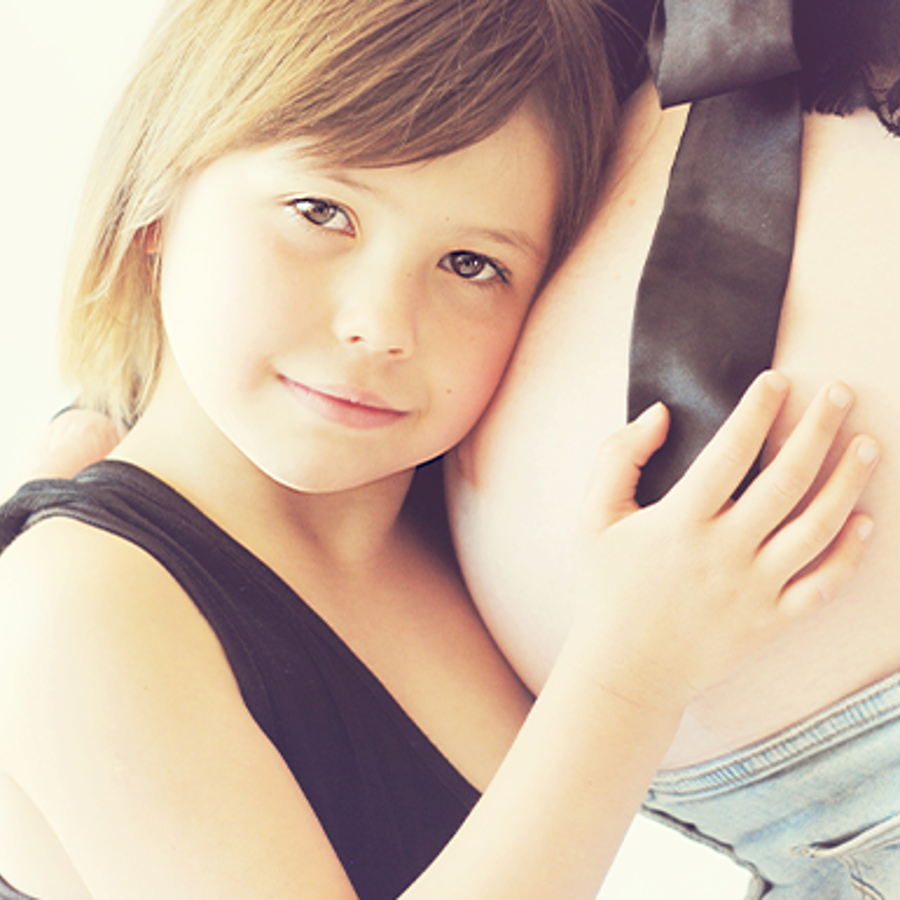
How is a balanced translocation inherited?
November 15, 2016

- Related Topics:
- Chromosomes,
- Translocation,
- Reproduction
A curious adult from Florida asks:
"I know someone with a balanced translocation. The doctor said there are four possible combinations for her kids. Can you explain what they are?"
Great question! Your friend’s doctor is right that there are four combinations for her kids.
This is important to know because two of the combinations might cause problems for the pregnancy and/or the child, and two won’t.
Three of these combinations are ways her kids could inherit the translocation. There is also one way her kids won’t end up with the translocation.
You might be wondering why this matters. Translocations can change the amount of DNA someone has and this can cause problems.
For example, Down syndrome happens when someone has an extra chromosome 21. In more severe cases extra DNA can lead to miscarriages.
Now this isn’t a problem for people with a balanced translocation because they have the typical amount of DNA. But as you’ll see below, it can be for their kids.
Balanced Translocations Happen When Chromosomes are Rearranged
First off, what’s DNA? DNA is the set of instructions for making a living thing.
Our DNA is packaged in structures called chromosomes. Most people have 23 kinds of chromosomes, and two copies of each kind. So we have 23 pairs for a total of 46.
A translocation is what we call it when a part of one chromosome is swapped with or attached to another chromosome. In a balanced translocation, there isn’t any lost or extra information. All the parts of the original two chromosomes are there with the usual number of copies.
This kind of translocation is pictured below:

On the left are two typical pairs of chromosomes. I have made them each a different color to make them easier to follow. One pair is called the Chr 1 pair and the other is Chr 2.
On the right is what might happen in a balanced translocation. As you can see, there was a swap between one of the Chr 1 chromosomes and one of the Chr 2 chromosomes. The end result is that there are now 4 different chromosomes instead of two of each.
I mentioned before that no information has been lost. Why does this matter? It turns out that it can be very important to have exactly two chromosomes.
As an example, let’s think about how the number of letters in a word can be important. The word “dessert” has two S’s. When we see this word, we know it’s referring to a yummy treat. If we rearrange the S’s, we still know we’re talking about a yummy treat.

However, if we delete one S, we change the meaning of the word! Now we’re not talking about a scoop of ice cream or a piece of cake anymore. Instead we’re talking about a place where it hardly ever rains.

What happens when we add an extra S? We end up with something meaningless.
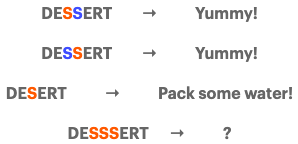
DNA sort of works the same way. There are parts of each chromosome that can cause problems if they are repeated or go missing.
Kids Get 23 Chromosomes from Each Parent
When people have children, each parent typically gives one copy of each of their 23 chromosomes. The mother will contribute an egg cell carrying her 23 and the father will contribute a sperm cell with 23 of his own.
This adds up to 23 pairs, or 46 total chromosomes.
Let’s see how this works using our parent with the balanced translocation. We’ll just focus on 1 out of 23 pairs--one with a balanced translocation.
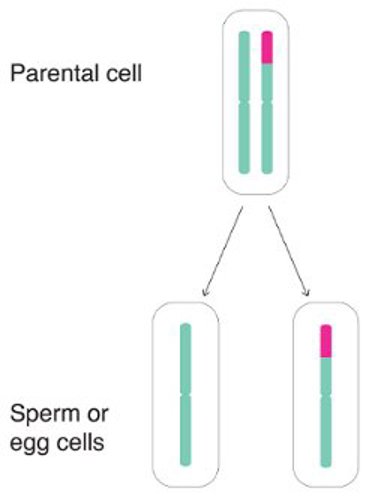
As you can see, one of this pair gets put into one sperm (or egg) and the other gets put in the second one.
That means that half of the sperm or egg cells from this parent will be like the cell on the left. The other half will be like the cell on the right.
This happens for all 23 pairs of chromosomes.
In real life this is a bit more complicated. Pairs of chromosomes can actually swap pieces in a process called recombination but this isn’t important for what I am talking about here. You can read more about that process here.
There are Four Combinations of Chr1 and Chr2
Now we know what a balanced translocation is and how parents pass on their chromosomes to their children. We have all the information we need to figure out the four combinations the child in question can inherit.
Let’s say a parent has the balanced translocation I showed earlier:
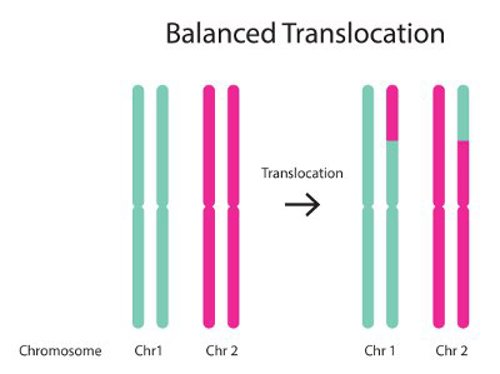
A child will get one copy of Chr 1 and one copy of Chr 2 from the parent carrying the translocation. There are four possible combinations of chromosomes 1 and 2.
Let’s draw all the possible combinations of Chr 1 and Chr 2 in a table. In each column of the table, we place a different version of Chr 1.
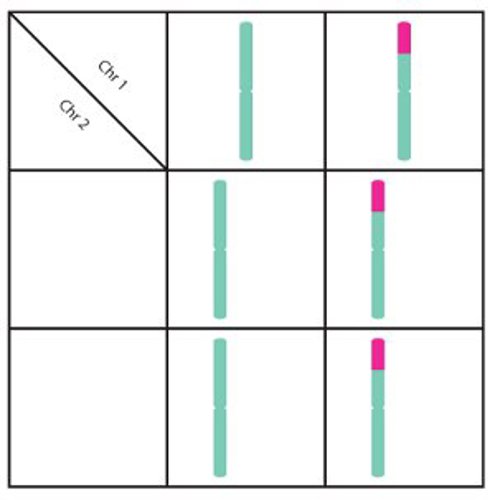
In each row we place a different version of Chr 2.
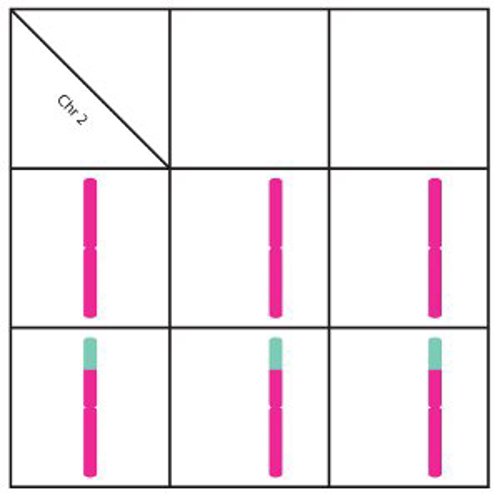
Now we fill in all of the boxes to show all the possible pairs.

I have marked each combination with a number to make them easy to refer to.
In combination 1, the child will inherit two chromosomes that are unaffected by the translocation. This is like what you find in the child of a parent that does not have a translocation.
In combination 4, the child will get affected versions of both chromosomes. In both of these cases the child will have all the information from Chr 1 and Chr 2. The only difference is that in combination 4, that information has been rearranged a bit like in the parent with the balanced translocation.
In combinations 2 and 3 that is not the case. Combination 2 is missing part of Chr 1, and has two copies of part of Chr 2. Combination 3 is the opposite, with part of Chr 2 missing and some extra chromosome Chr 1.
These are unbalanced translocations meaning some information has been lost and some has been duplicated. Our dessert has turned into a desert or a desssert.
Translocations Can Cause Health Problems
An unbalanced translocation can change the amount of DNA kids inherit. This can mean too many copies of some parts of chromosomes and too few copies of others.
This brings us back to the “dessert” example. Changing the number of S’s changes the meaning of the word “dessert”. Changing the number of chromosomes can change the way our bodies understand instructions in our DNA. This can increase the chance of miscarriage or developmental disorders.
Read More:
- Verywellfamily: Balanced translocations and recurrent miscarriages
- Rare Chromo, a support group for families affected by rare chromosome disorders, has an info sheet on balanced translocations

Author: Laura Lee
When this answer was published in 2016, Laura was a Ph.D. candidate in the Department of Biology, studying cellular identity maintenance in plants in Dominique Bergmann’s laboratory. Laura wrote this answer while participating in the Stanford at The Tech program.
 Skip Navigation
Skip Navigation
